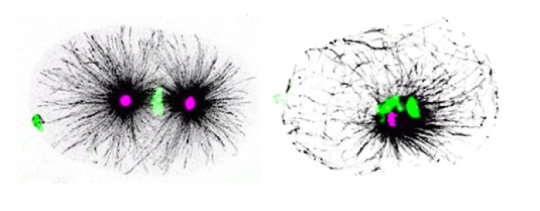[ad_1]
New cells are formed during cell division by a precisely regulated partitioning of cellular content into the two daughter cells. Cell division is therefore a fundamental biological process in which the replicated chromosomes of the mother cell are distributed equally to two daughter cells. This is accomplished by the attachment of the paired chromosomes to a bipolar network of fibers known as the spindle apparatus (or mitotic spindle). Shortening of the fibers then draws the two sets of chromosomes to opposite poles of the network, and a contractile ring in the center cleaves the cell in two. The mitotic spindle is organized by organelles known as centrosomes, which act as spindle poles. Defects in cell division which lead to incorrect segregation of the chromosomes can have grave consequences and are associated with diseases such as cancer. The research group led by Dr. Tamara Mikeladze-Dvali at the LMU Biocenter studies how cell division is regulated at the centrosomal level. Together with her team, she has identified a protein that plays an essential role in the assembly of the bipolar spindle in animal cells. The new findings appear in the journal Current Biology.
The centrosome is comprised of a pair of cylindrical centrioles, which are embedded in an amorphous protein matrix called the pericentriolar material (PCM). In the mother cell the centrosome is normally found in the vicinity of the cell nucleus, and is replicated prior to the onset of cell division. Each centrosome then acts as a nucleation site for the assembly of spindle fibers, which gradually pushes the two centrosomes apart and thereby forms a bipolar spindle. The replicated chromosomes attach to spindle fiber emanating from the centrosomes, and are pulled towards the pole associated with the fibers. In order to withstand the enormous pulling and pushing forces exerted during cell division, the centrosomes themselves must be very robust. This robustness is provided by the PCM matrix proteins.
Using the nematode Caenorhabditis elegans as a model system, Tamara Mikeladze-Dvali and her colleagues screened a random collection of genetic mutants for mutations that disrupt the formation of the mitotic spindle. “Analysis of such mutants can tell us which factors play an important role in cell division,” says Mikeladze-Dvali. “In this case, we came across a previously uncharacterized protein, which we named ‘PCM-deficient-1’, or PCMD-1 for short.” In subsequent experiments, the LMU researchers attached a fluorescent label to the protein, which enabled them to track its position in the cell and they specifically deleted the pcmd-1 gene with the aid of the CRISPR/Cas9 system. This approach enabled them to determine that the protein is essential for the correct assembly of the centrosome. In particular, it is required for the formation of the PCM matrix, which is largely made up of the protein SPD-5, and is responsible for the integrity and robustness of the centrosomes. “Loss of PCMD-1 has a drastic effect on the coherence of the centrosome and the assembly of the bipolar spindle, which effectively prevents normal cell division,” says Mikeladze-Dvali.
These findings reveal that PCMD-1 plays an indispensable role in the control of cell division, and according to the authors, its characterization has significant implications for our understanding of how centrosome assembly is regulated. The vast majority of the proteins identified in C. elegans -including the PCM protein SPD-5 — are also found in higher organisms, where they serve similar functions. Mutations in the human version of SPD-5 have been shown to be responsible for a genetic disease called primary microcephaly. “But in order to understand how this developmental defect arises, it is crucial to learn more about how the function of the protein is regulated at the cellular level,” says Mikeladze-Dvali.
Story Source:
Materials provided by Ludwig-Maximilians-Universität München. Note: Content may be edited for style and length.
[ad_2]















